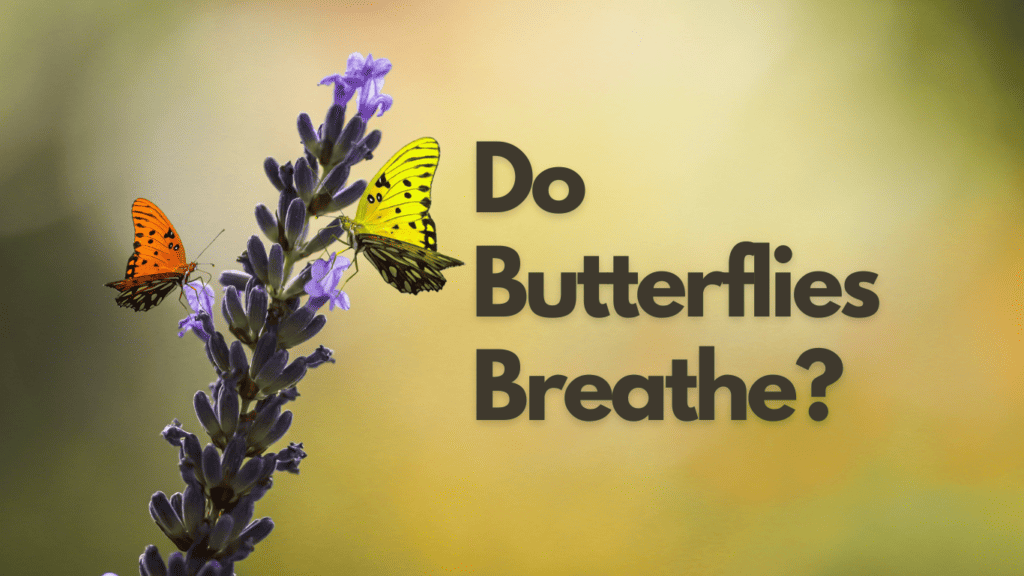Many curious minds have pondered over the intricacies of the animal kingdom and often wondered, “Do butterflies breathe?” The answer is, unequivocally, yes.
Unlike humans, who rely on the vital functions of their lungs and noses to facilitate the intake of oxygen, butterflies have adopted a unique and fascinating respiratory system. These delicate creatures breathe through a series of minuscule openings located along the sides of their bodies, aptly named “spiracles”.
Each of these spiracles is connected to a tube known as the “trachea”, which directly transports oxygen throughout their bodies. Remarkably, butterflies employ a passive respiration mechanism, a method that requires no active effort on their part. Through this method, oxygen is absorbed via chemical processes, making their respiratory system a wonderful testament to the intricate wonders of nature.
This article delves into the butterfly’s intriguing method of breathing, highlighting the role of spiracles and trachea, while comparing their passive respiration technique to the active methods seen in other species.

Butterflies and Respiration
Understanding Spiracles
Butterflies breathe through tiny openings on the sides of their bodies called spiracles. These spiracles allow oxygen to enter the body and carbon dioxide to exit. Butterflies have nine pairs of spiracles running along their thorax and abdomen.
Role of Trachea in Breathing
Each spiracle is connected to a tube called a trachea, which carries air to different parts of the body. The trachea is lined with chitin, a hard, protective material that helps keep the tube open. Oxygen diffuses from the trachea into the body tissues, and carbon dioxide diffuses out of the tissues and into the trachea.
Active and Passive Respiration
Butterflies do not have active respiratory organs like lungs, which require the animal to inhale a breath using specialized muscles. Instead, they use a passive form of respiration that requires no active participation of the butterfly. Passive respiration uses chemical processes to take in oxygen.
Gas Exchange and Carbon Dioxide Release
During gas exchange, oxygen enters the trachea and diffuses into the body tissues, while carbon dioxide diffuses out of the tissues and into the trachea. The carbon dioxide then exits the body through the spiracles. Butterflies also release excess water vapor through their spiracles, which helps regulate their internal moisture levels.
Anatomy of Butterfly Respiratory System
Abdomen and Thorax
The respiratory system of a butterfly is primarily located in its abdomen and thorax. Spiracles, which are tiny holes, are located along the length of the body, but mainly focused down the sides of the abdomen. These spiracles are the mechanism through which butterflies take in oxygen and expel carbon dioxide. Some spiracles are dedicated to taking in oxygen, while others are used to expel carbon dioxide.
Muscles and Tracheal Tubes
Butterflies have tracheal tubes that carry oxygen all over the body, which is why a butterfly is said to have passive respiration. These tracheal tubes are supported by specialized muscles that help regulate the flow of air in and out of the spiracles. The tracheal tubes branch out into smaller tubes, called tracheoles, which are in close contact with the cells of the body, allowing for efficient gas exchange.
Specialized Muscles
The specialized muscles that support the tracheal tubes are located in the thorax of the butterfly. These muscles are responsible for controlling the flow of air in and out of the spiracles, as well as regulating the size of the tubes. The muscles work in conjunction with the spiracles to ensure that the butterfly is able to efficiently take in oxygen and expel carbon dioxide.
Influence of External Factors
Temperature and Humidity
The temperature and humidity of the environment play a crucial role in the growth and development of butterflies. Since they are cold-blooded creatures, their body temperature is regulated by the temperature of their surroundings.
The ambient air temperature has a great influence on their metabolism, growth, and development. The humidity of the environment also affects their growth and development. High humidity levels can cause fungal infections, while low humidity levels can cause dehydration.
Light and Dark
Butterflies are diurnal creatures, which means they are active during the day and rest at night. The amount of light they receive affects their behavior and physiology. Light is essential for their vision, navigation, and thermoregulation. Butterflies use the sun’s rays to warm their bodies, which increases their metabolic rate. The absence of light triggers their resting behavior and reduces their metabolic rate.
Movement and Flight
Butterflies are highly active creatures that require a lot of energy to move and fly. They use their wings to fly, and their muscles to move and walk. Movement and flight are essential for their survival, as they need to find food, mates, and suitable habitats. Butterflies also need to avoid predators and adverse environmental conditions. They can fly at different speeds and altitudes, depending on their species, size, and physiology.
Respiration in Different Life Stages
Caterpillars and Larvae
Caterpillars and larvae breathe through tiny pores called spiracles on their exoskeleton. These spiracles allow air to enter and exit the body, providing oxygen for respiration. However, caterpillars and larvae do not have lungs or any active respiratory organs. Instead, they rely on passive respiration, which uses chemical processes to take in oxygen.
Metamorphosis and Cocoon
During metamorphosis, the caterpillar transforms into a butterfly inside a cocoon. This transformation involves the complete restructuring of the body, including the respiratory system. As the caterpillar enters the cocoon, it stops breathing and becomes dormant. Inside the cocoon, the caterpillar undergoes a process of cellular breakdown and reorganization, which includes the development of a new respiratory system.
Adult Butterflies
Once the butterfly emerges from the cocoon, it has a fully developed respiratory system. Adult butterflies breathe through spiracles, which are located on their exoskeleton. These spiracles are connected to tracheae, which are tiny tubes that transport oxygen to the body. Unlike caterpillars and larvae, adult butterflies have an active respiratory system that allows them to regulate their breathing rate and take in more oxygen when needed.
Comparative Analysis
Butterflies vs Humans
Butterflies and humans have very different respiratory systems. While humans use their lungs to breathe, butterflies breathe through tiny pores called spiracles. Butterflies have spiracles all over their bodies, mainly in the exoskeleton.
The spiracles lead to tracheal tubes that carry oxygen all over the body, which is why a butterfly is said to have passive respiration. In contrast, humans have active respiration, where air is actively drawn into the lungs and then expelled.
Butterflies vs Aquatic Insects
Aquatic insects, such as dragonflies and mayflies, have a very different respiratory system than butterflies. They breathe through gills, which extract oxygen from the water. Butterflies, on the other hand, breathe air through spiracles and tracheal tubes. While aquatic insects can extract oxygen from water, they cannot survive in air, unlike butterflies.
Butterflies vs Moths
Butterflies and moths have similar respiratory systems, both using spiracles and tracheal tubes to breathe. However, moths have a unique structure called a proboscis, which is used to suck nectar from flowers.
Butterflies also have a proboscis, but it is shorter and not as specialized as that of moths. In terms of respiration, both butterflies and moths have passive respiration, where air is drawn in through spiracles and then diffuses through the tracheal tubes.
Unique Respiratory Features
Monarch Butterflies
Monarch butterflies are known for their unique migration patterns, but they also have unique respiratory features. Monarchs have a larger surface area of spiracles, which are tiny pores on their body that allow for gas exchange. This allows for more efficient oxygen uptake during their long flights.
Respiratory Organs
Butterflies do not have lungs like humans. Instead, they have a network of tubes called tracheae that deliver oxygen directly to their cells. The tracheae are connected to the spiracles and branch out throughout the butterfly’s body.
Proboscis
The proboscis is the long, tube-like mouthpart of the butterfly. It is used for feeding and also plays a role in respiration. The proboscis is lined with tiny tubes that allow oxygen to diffuse into the butterfly’s body.
Hindwings
The hindwings of butterflies also play a role in respiration. When at rest, the hindwings are held perpendicular to the body, creating a small gap between the wings and the body. This gap allows for air to flow in and out of the spiracles, facilitating gas exchange.
Frequently Asked Questions
How do butterflies obtain oxygen?
Butterflies obtain oxygen through tiny pores in their body called spiracles. These spiracles are present all over the butterfly’s body, mainly in the exoskeleton. Also, the butterflies have tracheal tubes that carry oxygen all over the body, which is why a butterfly is said to have passive respiration.
What is the respiratory system of a butterfly?
The respiratory system of a butterfly consists of spiracles and tracheal tubes. Spiracles are tiny pores present all over the butterfly’s body that allow air to enter the body. Tracheal tubes are a network of tubes that carry oxygen from the spiracles to the body tissues.
Do butterflies have lungs?
No, butterflies do not have lungs. Instead, they have a network of tracheal tubes that carry oxygen all over the body.
What is the breathing organ of a butterfly?
The breathing organ of a butterfly is the spiracle. These tiny pores are present all over the butterfly’s body and allow air to enter the body.
How do butterflies breathe?
Butterflies breathe through spiracles, a type of tiny hole. They have multiple spiracles along their external skeletons, called the exoskeleton. These spiracles allow air to enter the body and reach the tracheal tubes, which then carry oxygen to the body tissues.
Do butterflies exhale carbon dioxide?
Yes, butterflies exhale carbon dioxide just like humans and other animals. When oxygen is used by the body tissues, carbon dioxide is produced as a waste product and is exhaled through the spiracles.
Recent Posts
How Can I Create A Habitat For Skipper Butterflies In My Garden With 3 Easy Plants
Skipper butterflies are a diverse group of insects that are found all over the world. They are known for their quick, darting flight and their often colorful wings. Skippers are attracted to...
Common Species Of Butterflies In Maryland: 21 Unique Species
Maryland is home to a variety of beautiful butterflies, from the large and showy Eastern Tiger Swallowtail to the tiny and delicate Blue Dasher. There are over 150 species of butterflies in Maryland,...
